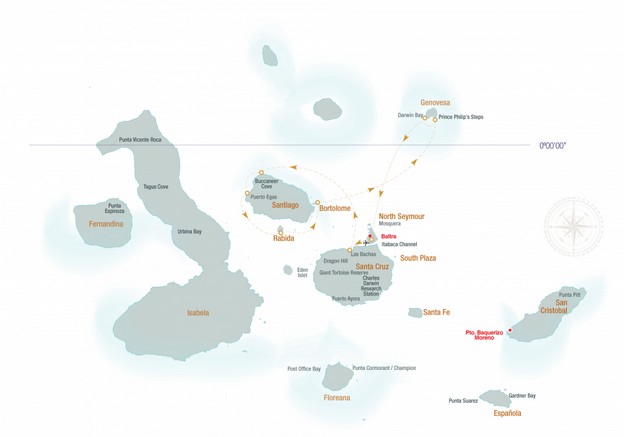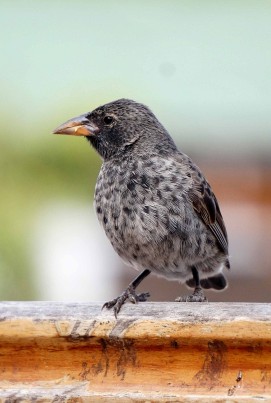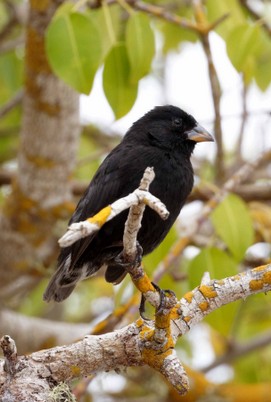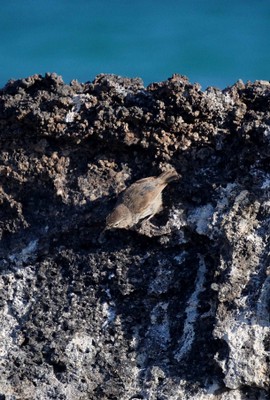2017.02.02.2
Files > Volume 2 > Vol 2 No 2 2017
CARTA AL EDITOR / LETTER TO EDITOR
The Galápagos Islands: relatively untouched, but increasingly endangered
Las Islas Galápagos: relativamente intactas, pero cada vez más amenazadas
Las Islas Galápagos: relativamente intactas, pero cada vez más amenazadas
Markus P. Tellkamp
Available from: http://dx.doi.org/10.21931/RB/2017.02.02.2
_______________________________________________________________________________________________________________________
Hardly any place on the planet evokes a sense of mystique and wonder like the Galápagos Islands (Figure 1). They are the cradle of evolutionary thought. They also are home to an unusual menagerie of animals, such as prehistoric-looking iguanas that feed on algae, giant tortoises, the only species of penguin to live on the equator, a flightless cormorant, a group of unique an famous finches, furtive and shy rice rats, sea lions and fur seals. Visitors have to be careful not to step on the oxymoronically extremely tame wildlife. Endemic plants, such as tree-like cacti, Scalesia trees and shrubs (relatives of sunflowers and daisies), and highland Miconia shrubs cover different island life zones. Around the world, people may not have heard much of Ecuador, the small South American country that proudly calls the islands its own, but they likely have heard of the famed Galapagos. Apart from the extraordinary sensation of experiencing wildlife up close, however, what makes these islands so special?

Figure 1. The Galápagos Islands are an archipelago of volcanic islands distributed on either side of the Equator in the Pacific Ocean surrounding the centre of the Western Hemisphere, 906 km west of continental Ecuador, of which they are a part
To answer this question, it is worthwhile to compare the Galápagos Islands to other islands of the Pacific region. The most obvious comparison is with the Hawaiian Islands, an archipelago of similar geological hotspot origin but older. Although there are many examples, I focus here on two related groups of birds. Although others taxonomic groups mirror the general trends seen in these birds. In Hawaii as in the Galápagos, a group of finches has evolved and diversified by adaptive radiation. No matter which way one chooses to look at these birds, the Hawaiian honeycreeper (Fringillidae: Drepanidinae) radiation is by far the more spectacular: about 40 colorful species of birds, some of which do (or did) not bear any resemblance to a ‘typical’ finch, occupy a variety of niches, feeding on nectar, snails, insects, fruits, leaves or combinations thereof 1. Despite the magnificence of honeycreepers, the more commonly known example of adaptive radiation is that of the Galápagos finches (Thraupidae). A look at the current conservation status of these two groups of birds may reveal why. Of the 35 species of honeycreeper listed by the IUCN, representing only the historically known species, 16 are extinct, 12 are critically endangered, two endangered, and the remaining five vulnerable 2. In practical terms, this means that you can visit the Hawaiian Islands without seeing a single honeycreeper. In contrast, the Galápagos Finches are all still very much extant and, with important exceptions, quite numerous. In fact, you can easily see five of the 14 species of Galápagos Finches during a morning stroll through the town of Puerto Ayora. The Galápagos finches thus allow for fine-grained and intricate analyses of their evolutionary history 3. In contrast, a recent phylogenetic study 4 on the Hawaiian honeycreeper was limited in scope by the lack of genetic material from the extinct species (Figure 2).
Figure 2. a) A female Common Cactus-Finch (Geospiza scandens) watches the author at lunch in Puerto Ayora, Santa Cruz Island, hoping to snatch away some food. b) A male Small Ground-Finch (Geospiza fuliginosa) searching for food in the arid zone of Santa Cruz Island. c) A Gray Warbler-Finch (Certhidea fusca) searching tidal rocks for food on Genovesa Island. Visiting the Galápagos Islands, it is literally impossible to miss the famous finches.
In nearly every taxonomic group the pattern is the same: on the Galápagos Islands, far fewer extinctions have taken place and the populations of the extant species tend to be larger. Why are the finches and fellow endemic species on the Galápagos in better shape than their Hawaiian counterparts? The short answer is people. Polynesians colonized the lush tropical Hawaiian archipelago with nutrient rich volcanic soils about 1600 years ago 5. Over the last two centuries, the human population there has even grown to an estimated population of 1,428,557 people by 2016 6. In contrast, humans have shunned the dry, spiny, and desert-like Galápagos Islands for a long time. If Polynesians ever made it to the Galápagos Islands, they did not stay around. Nowadays, only 3% of the surface area of the islands can be settled by people, with the remaining Galapagos 97% being protected as a national park. A total of 25,244 people were registered during the 2015 census 7. Now, the human population is tightly controlled on the Galápagos. Even for an Ecuadorean citizen, a trip to the islands feels more like an international trip than a national one. The little appeal the Galápagos had for people in the past is the main reason the flora and fauna is still quite intact (Figure 3).

Figure 3. A female Common Cactus-Finch (Geospiza scandens; left) and a female Medium Ground-Finch (Geospiza fortis; right) looking for scraps just after patrons of restaurant left, Puerto Ayora, Santa Cruz.
Only about 13 species of terrestrial vertebrates have become extinct in historic time 8, although entire populations of some species have been extirpated on some islands 9. In the broad spectrum of human impact among all Pacific islands, the Galápagos are perhaps the least impacted. At the other extreme, having passed through a devastating anthropogenic cataclysm, we have the Easter Islands whose terrestrial ecosystems have been nearly completely transformed 10. The Hawaiian Islands fall somewhere in between.
The fact that the islands are still largely intact should not be viewed with passive complacency. Anthropogenic processes have already been set in motion that are starting to threaten this fragile island ecosystem. First among them are introduced species that are displacing, infecting or eating native plants and animals. According to the Charles Darwin Station 11, there are now nearly 2000 introduced species, some of which are wreaking serious havoc on the islands. For example, going back to the finches, one of the introduced parasites is now seriously threatening the famous Galápagos Finches, especially the critically endangered Mangrove Finch (Camarhynchus heliobates). The parasitic fly Philornis downsii has been identified as the main threat to survival of several finch species 12. It may also be responsible for the extinction of the newly confirmed species of San Cristóbal Vermillion Flycatcher (Pyrocephalus dubius)13. In an attempt to eradicate invasive species, authorities are sometimes resorting to drastic measures. For example, tens of thousands of goats have been eliminated from several islands at great cost 14. This well-meaning measure has had its ecological backlash, however. Officials from the Ministry of Agriculture, Fishing and Livestocok have noted that in the absence of the introduced herbivore, the first plants to recolonize goat-ravished areas are introduced, invasive species which are outcompeting the native species. In addition, populations of Galápagos Hawks (Buteo galapagoensis) have diminished 15 as changes in habitat structure due to goat removal have made hunting for these animals more difficult 16. Introduced species are perhaps the gravest problem, but the World Heritage Committee identified illegal and unsustainable fishing, tourism, immigration, lack of education, and problematic governance as major threats as well 17. Clearly, the islands require a creative and holistic approach for solving conservation problems.
The Galápagos Islands are unique because of the limited damage people have done to its native flora and fauna. At the same time, they are increasingly under pressure from anthropogenic causes. In order to safeguard the islands into the future, a new generation of natural resource managers needs to be trained that is capable of using the latest technology and insights in the natural and social sciences 18 to properly solve the problems faced by the island’s biota. In addition, the full potential for the islands to become a unique natural laboratory has not been realized yet. The Galápagos require modern laboratories in addition to an intellectual research environment that is wholly based on the islands. National and foreign scientists can contribute to safeguard the islands, not only by creating and sharing knowledge, but also by increasing awareness in the population, and attracting funds for research and conservation. For this to happen, the scientific community not only needs the right incentives (particularly ease of access) to invest in the islands, but they also need qualified islanders who can at some time run the future labs. Perhaps it is time for a “University of the Galápagos Islands?”
References
1. Pratt HD (2005) Hawaiian honeycreepers. New York: Oxford University Press.
2. IUCN (2016) The IUCN red list of threatened species, Version 2016-3. http://www.iucnredlist.org. Accessed on 26 April 2017.
3. Lamichhaney S, Berglund J, Almén MS, et al. (2015) Evolution of Darwin’s finches and their beaks revealed by genome sequencing. Nature 518: 371–375. doi:10.1038/nature14181
4. Lerner HRL, Meyer M, James HF, et al. (2011) Multilocus resolution of phylogeny and timescale in the extant adaptive radiation of Hawaiian honeycreepers. Current Biology 21: 1838–1844. doi: 10.1016/j.cub.2011.09.039
5. Kirch PV (1985) Feathered gods and fishhooks. Honolulu: University of Hawaii Press.
6. U.S. Census Bureau (2016) Quick facts Hawaii. https://www.census.gov/quickfacts/table/PST045215/15. Accessed on 26 April 2017.
7. Instituto Nacional de Estadística y Censos (2015) Galápagos tiene 25.244 habitantes según censo 2015. http://www.ecuadorencifras.gob.ec/galapagos-tiene-25-244-habitantes-segun-censo-2015/. Accessed 19 April 2017.
8. Jiménez-Uzcátegui G, Milstead B, Marquez C, et al. (2008) Galapagos vertebrates: endangered status and conservation actions. Pages 104–153 in Galapagos Report 2006-2007. Puerto Ayora: CDF, GNP and INGALA. http://www.darwinfoundation.org/media/filer_public/12/60/1260db98-2811-46d1-8c3b-0c3b9cf9ecb3/galapagos_report_2006-2007_english.pdf. Accessed on 26 April 2017.
9. Steadman DW, Stafford TW, Donahue DJ & Jull AJT (1991) Chronology of Holocene Vertebrate Extinction in the Galapagos Islands. Quaternary Research 36: 126-133. https://doi.org/10.1016/0033-5894(91)90021-V
10. Steadman DW (1995) Prehistoric extinctions of Pacific island birds: biodiversity meets zooarchaeology. Science 1123–1131. doi: 10.1126/science.267.5201.1123
11. Gardener M, Causton C, Atkinson R, Guézou A (2011). CDF Checklist of Galapagos Introduced Species - FCD Lista de especies de Especies Introducidas de Galápagos. In: Bungartz F, Herrera H, Jaramillo P, et al. (eds.). Charles Darwin Foundation Galapagos Species Checklist. Puerto Ayora: Charles Darwin Foundation http://darwinfoundation.org/datazone/checklists/introduced-species/ Last updated 05 Jul 2011
12. Fessl B & Tebbich S (2002) Philornis downsi – a recently discovered parasite on the Galápagos archipelago – a threat for Darwin’s finches? Ibis 144: 445–451. doi/10.1046/j.1474-919X.2002.00076.x
13. Carmi O, Witt CC, Jaramillo A & Dumbacher JP (2016) Phylogeography of the Vermilion Flycatcher species complex: Multiple speciation events, shifts in migratory behavior, and an apparent extinction of a Galápagos-endemic bird species. Molecular Phylogenetics and Evolution 102: 152–173. http://dx.doi.org/10.1016/j.ympev.2016.05.029
14. Carrion V, Donlan CJ, Campbell KJ, et al. (2011) Archipelago-wide island restoration in the Galápagos Islands: reducing costs of invasive mammal eradication programs and reinvasion risk. PLoS ONE 6(5): e18835. doi:10.1371/journal.pone.0018835
15. Rivera-Parra JL, Levenstein KM, Bednarz JC, et al. (2012) Implications of goat eradication on the survivorship of the Galapagos hawk. Journal of Wildlife Management 76: 1197–1204. doi: 10.1002/jwmg.372
16. Jaramillo M, Donaghy-Cannon M, Vargas F H & Parker PG (2016) The diet of the Galapagos Hawk (Buteo galapagoensis) before and after goat eradication Journal of Raptor Research 50: 33–44. doi: 10.3356/rapt-50-01-33-44.1
17. Strahm W & Patry M (2010) World Heritage Centre/IUCN Reactive Monitoring Mission Report Galapagos Islands 27 April–6 May 2010. Paris: World Heritage Center UNESCO. http://whc.unesco.org/en/documents/104554.
18. Watkins G (2008) A paradigm shift in Galapagos research. Galapagos Research 65: 30–36.
All birds pictures used in this articles belongs to the author Markus P. Tellkamp
School of Biological Sciences and Engineering
Yachay Tech
Hacienda San José s/n Urcuquí, Ecuador
E-mail: [email protected]
Yachay Tech
Hacienda San José s/n Urcuquí, Ecuador
E-mail: [email protected]



